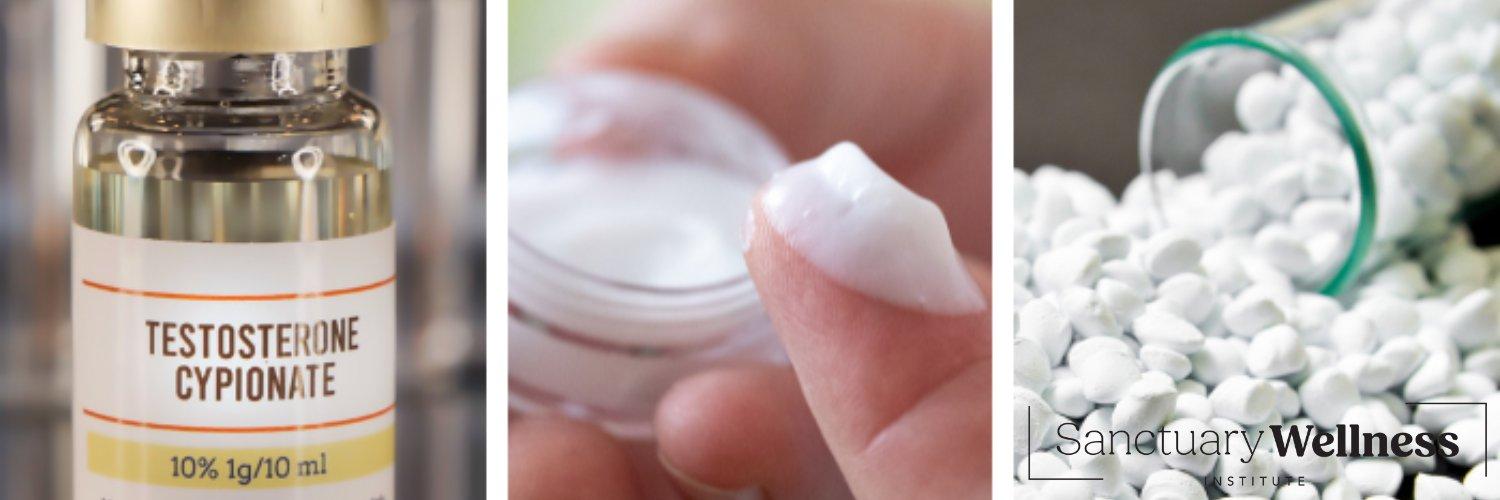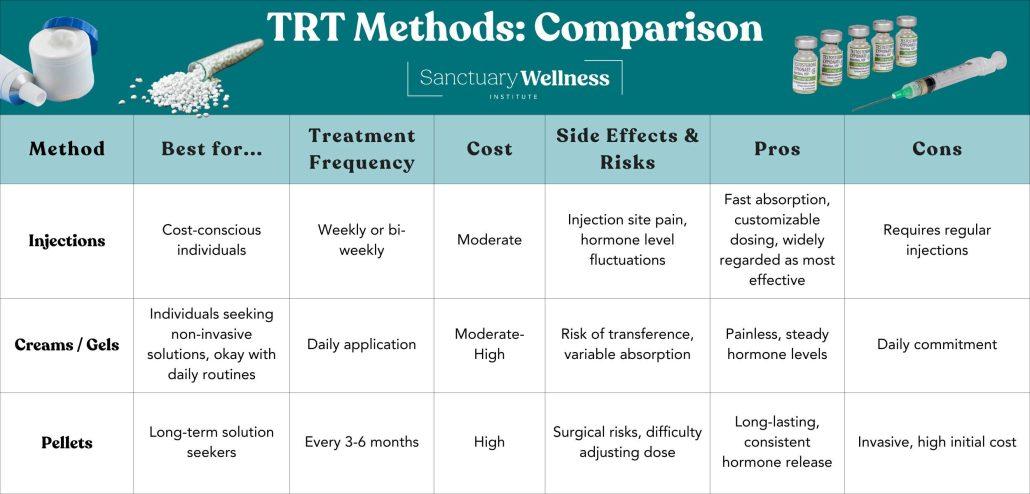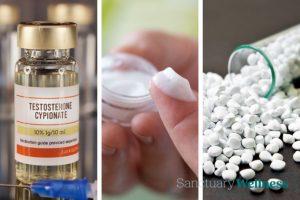- John DiBella
- Published: January 23, 2025
- Updated: July 22, 2025
- Fact-checked by Dr. Desiree Granados

Testosterone Replacement Therapy (TRT) is a common solution for individuals experiencing low testosterone levels. While this therapy can significantly enhance energy, mood, and overall health, choosing the right method of administration is crucial.
Among the popular options are testosterone injections, creams, and pellets, each with distinct advantages and drawbacks. In this blog we’ll explore some of the most popular TRT methods and the main considerations to make when deciding which is right for you.
Comparing Testosterone Replacement Therapy Methods
Testosterone Injections
Testosterone injections are one of the most commonly used and effective methods for testosterone replacement therapy (TRT). A study published in the American Journal of Physiology – Endocrinology and Metabolism, found injections to have less risks, and increased musculoskeletal benefits compared to transdermal applications such as creams.
Administered intramuscularly, these injections deliver testosterone directly into the bloodstream for consistent absorption. Injections are typically performed every 1-2 weeks.
Pros:
- Fast and reliable absorption
- Customizable dosing
- Lower cost compared to other methods
- Widely regarded as safest and most effective
Cons:
- Requires regular visits to a healthcare provider or self-injection (every 1-2 weeks)
- Potential for fluctuating hormone levels if not timed correctly
- May cause discomfort at the injection site
Injections are often favored by individuals who prefer control over their dosing schedule. While some may find the routine inconvenient, others appreciate the simplicity and efficiency of this method. Additionally, injections are widely available, making them a practical choice for most patients.
At The Sanctuary Wellness Institute, we only prescribe injectable testosterone cypionate to our patients. Both scientific research and our own experience suggest that injections are the most effective form of TRT for most patients.
Another important benefit of injections is that their dosage can be customized. As with all of our services at The Sanctuary, we tailor our prescriptions to each patient’s unique needs and circumstances. We believe this approach yields the best results and promotes the patient’s overall well-being.
Testosterone Creams / Gels
Testosterone creams or gels are applied directly to the skin, where they are absorbed into the bloodstream. This method is non-invasive and typically applied daily. A study published in The Journal of Clinical Endocrinology and Metabolism shows that testosterone gel leads to an increase in lean mass and muscle strength.
Pros:
- Non-invasive and painless
- Allows for steady hormone levels with daily application
Cons:
- Risk of accidentally transferring testosterone to others through skin contact
- Requires daily commitment
- Absorption can vary depending on skin type and application site
Creams are ideal for those who dislike needles or invasive procedures. However, the daily application requirement can be a drawback for individuals with busy lifestyles. Proper application techniques are essential to avoid unintended exposure to family members or others.
Testosterone Pellets
Testosterone pellets are small, solid implants inserted under the skin during a minor surgical procedure. They slowly release testosterone over several months, reducing the need for frequent dosing. A study published in 2017, found that implanted testosterone pellets improved ratings of sexual dysfunction and androgen deficiency.
Pros:
- Long-lasting, requiring fewer treatments (administration every 3-4 months)
- Consistent hormone delivery
Cons:
- Invasive procedure with risks like infection
- Higher initial cost
- Difficult to adjust dosage once implanted
Pellets are well-suited for patients seeking a “set-it-and-forget-it” approach. Despite the higher initial investment, many individuals find the convenience and long-term consistency worth the effort.
However, adjustments to dosage require another procedure, which may not be ideal for everyone. If the pellet’s dose is too high, patients can suffer a range of adverse side effects.
Which Form of Testosterone Should You Choose?
The choice between injections, creams, and pellets often depends on your lifestyle, budget, and personal preferences. For those seeking flexibility and cost-effectiveness, injections are a popular choice. Creams may appeal to individuals who prefer a non-invasive, daily routine. Pellets are ideal for those seeking long-term solutions with minimal maintenance but are willing to undergo a minor surgical procedure.
For example, if you travel frequently, injections might be more practical than creams, which require consistent daily application. On the other hand, pellets might be a better fit for individuals with a stable routine who want to avoid the hassle of frequent dosing. Your healthcare provider will evaluate your medical history, hormone levels, and personal preferences to recommend the most suitable option.
TRT Options Chart
Below is a comprehensive comparison of testosterone methods (injections, creams, and pellets) to guide your decision:

This chart provides a side-by-side comparison to simplify the decision-making process. By understanding the unique features of each method, you can weigh the benefits and drawbacks in light of your personal goals and circumstances. However, we always recommend you consult with a doctor to get professional insights about which option is best for you.
Conclusion
At The Sanctuary, we generally recommend TRT in injection form due to its effectiveness and ability to be customized. Nevertheless, creams provide a painless, daily option, while pellets offer a low-maintenance, long-term solution.
Each method has unique pros and cons, emphasizing the importance of personalized treatment plans. At The Sanctuary Wellness Institute, we provide testosterone replacement therapy and hormone replacement therapy tailored to your needs. Our experienced doctors will guide you toward understanding the TRT method that’s best for you.
States Where We Offer TRT Services
- West Virginia
- More coming soon!
How we reviewed this article:
- Stephen E Borst, Joshua F Yarrow (2015). Injection of testosterone may be safer and more effective than transdermal administration for combating loss of muscle and bone in older men
https://pmc.ncbi.nlm.nih.gov/articles/PMC6189635/ - C Wang, et al. (2000). Transdermal testosterone gel improves sexual function, mood, muscle strength, and body composition parameters in hypogonadal men
https://pubmed.ncbi.nlm.nih.gov/10946892/ - Chris G. McMahon, et al. (2017). Pharmacokinetics, Clinical Efficacy, Safety Profile, and Patient-Reported Outcomes in Patients Receiving Subcutaneous Testosterone Pellets 900 mg for Treatment of Symptoms Associated With Androgen Deficiency
https://www.sciencedirect.com/science/article/pii/S1743609517312596 - Jennifer J Shoskes, Meghan K Wilson, Michael L Spinner (2016). Pharmacology of testosterone replacement therapy preparations
https://pmc.ncbi.nlm.nih.gov/articles/PMC5182226/
Current Version
January 23, 2025
Written By
John DiBella
Fact-checked By
Dr. Desiree Granados
Editorial Process
Our Editorial Process

John DiBella is the co-founder and CEO at The Sanctuary Wellness Institute. His goal is to foster healthier lifestyles to improve individuals’ quality of life and health span through online medical and non-medical services. When he’s not writing health & wellness articles for The Sanctuary, he enjoys hiking, camping, surfing and sailing.







